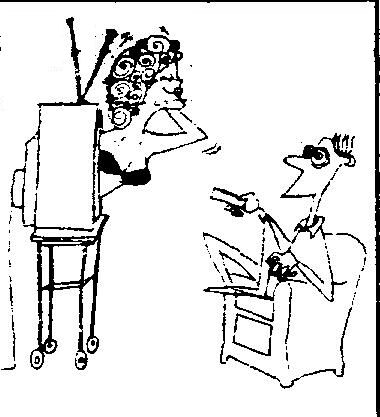
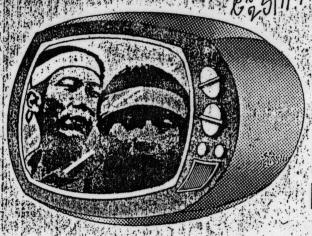
 |
 |
Preliminar comments__________________________________________________
Holography is the only technique allowing many observers located at different lateral position to watch threedimensional images without needing goggles. In some cases color is reproducted, but usually color technique is not applied yet. Even so, very impressive scenes are created, in artificial colors. Animating images in a traditional way is rather limited in holography, because holograms are registered in film by means of laser light, being not practical for illuminating a large ambience. Holographic TV is a wish of the public which starts to have some developments in the last decade. There are goggles 3D TV prototypes, but all have at least one of the following drawbacks:
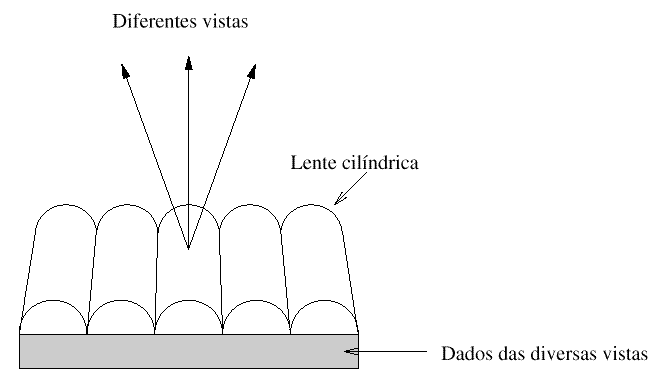
Campinas State University is ahead on this subject fromm the moment when invented the diffrative screen asociated to white light processes. There are prototyposto show, even to the common public, the possibility of reaching the final goal. Even so, the public can be more impressed now by some images obtained under some limitations, but which can be more bright and sharp.
System 1
The first model of 3D TV without goggles was made in 1988, being divulgates in the beginning of 1989 (1). It was the consequence of the evolution of the idea of the holographic screen, which was never before thought as capable of reproducing a continuous sequence of viewpoints (parallax), under white light. This was done for horizontal parallax only, separating the field of view of a camera into right and left views by means of mirrors, like in some stereoscopic photographic cameras.
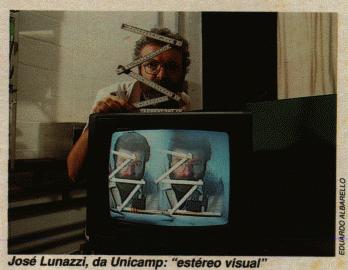 Photo published in
magazine Superinteressante, 1990
Photo published in
magazine Superinteressante, 1990
When observing, a common TV viewer was employed e and two equal lenses, so that each field on the TV was projected superimposed on the diffractive screen. The latter was at some angle with the projection, while the observer looked frontally to the screen.
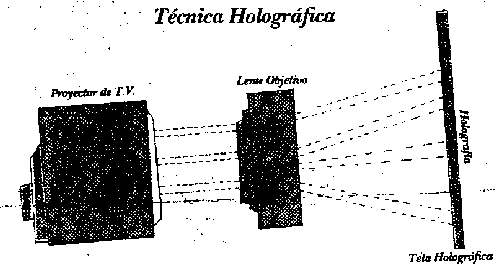
ESTEREO OBSERVATION, FIGURE DIVULGATED IN "FOLHA
DE SÃO PAULO".
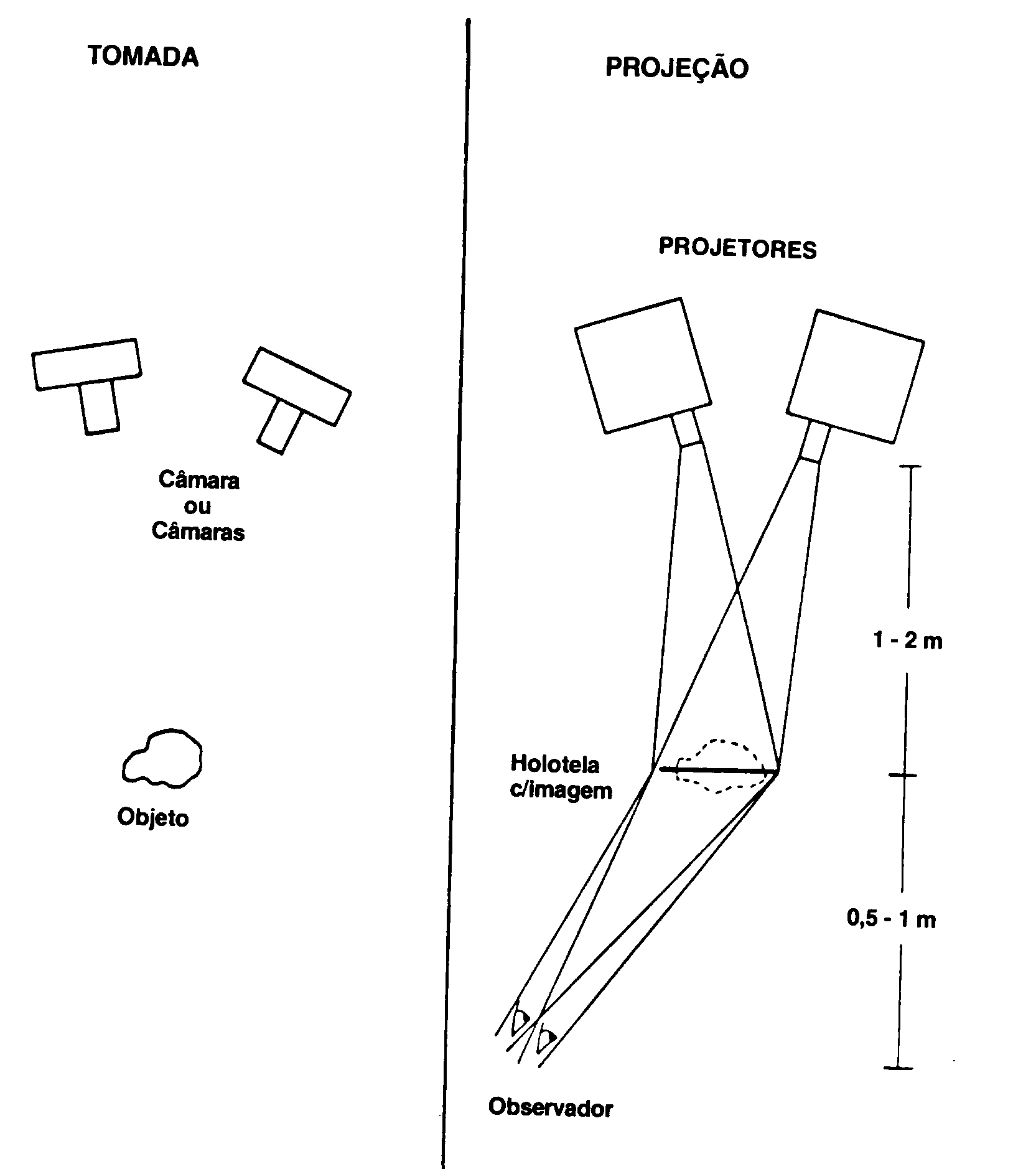
AN EQUIVALENT TO THE EMPLOYED SYSTEM, BUT
EMPLOYING TWO CAMERAS AND TWO TV PROJECTORS.
The scene is very deep, as in stéreo 3D cinematography, as and sharp as half of a television frame.
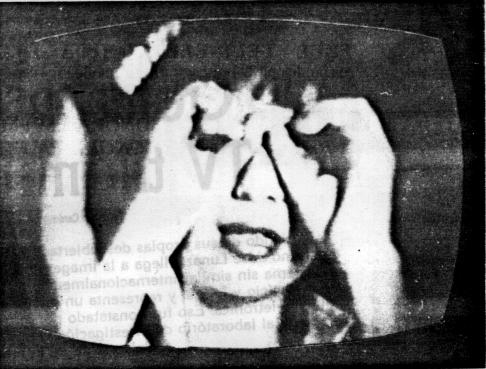
This picture was obtained from the image at the holographic screen, and was published in the latinamerican bilingüe magazine "Radiodifusão TV/Radiodifusión TV", 1989
This great result was a shortcut in the way to the final solution. I does not brings freedom of movementes to the three people who can observe simultaneously, and it was dim. But, an advantage is that brings most of the original color. The feeling of realm is fantastic. It was well divulgated in 1989 (2-14) exhibiting at the "I Semana de Arte da UNICAMP" and at the "Museu Dinâmico de Ciências de Campinas", showing mimicals of the actor Luiz Otávio Burnier. It was aldo exhibited in Argentina at the "Comissão de Energia Nuclear-CNEN", (3-6), and in 1990 at a course of optics at the center of theoretical physics ICTP at Trieste, Italy, and within the project Media Park at the city of Koln, Alemanha, and at the Photography Center of the Rochester Institute of Technology-RIT, Rochester, USA.
Some years later, when television projectors were populars, was possible to give brightness to the system. Our research was not conducted to the commercial application because of the mentioned drawbacks. We went towards the complete solution of the problem.
This solution, which permits the observers to move freely around the image, was theoretically predicted in 1994 and well experimentally obtained in 1997.
System 2
A holographic screen is an element made by superposing (interfering) two beams coming from a single laser into a high resolution film (holographic film) which is developed as conventional photograpic film is, then bleached. It looks almost transparent ans acts by diffracting light. We were the first to perform white light applications.
This other shortcut to the solution allows since
1993 to reach the public in a simpler way, bringing large size
images up to 0.75 m x 1.14m in portrait format.
Ten people can observe simultaneously in a dim ambient.
A room with minimal dimension of 6 m wide and 12 m deep is the ideal.
The public can see an image floating in front of the moldure of the
screen, u to 1 m in front of it.
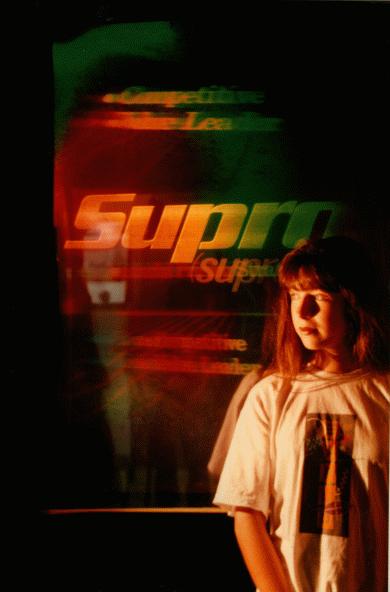
Text being projected in three fixed planes on the holographic screen,
one behind if, (upper text), another at the screen (central text)
and another in front of the screen (lower text).

The lower text ("Crowded Market") appears to the observer at the
position where the hand is.
System for holoprojection of TV images in holographic screen of 89 cm x 55 cm (landscape format) at a fixed plane 50 cm in frent of the screen.
Conventional TV images appear
at a plane that appears like a ghost in front of the screen,
rendering at a certain distance the ilusion of holographic images.
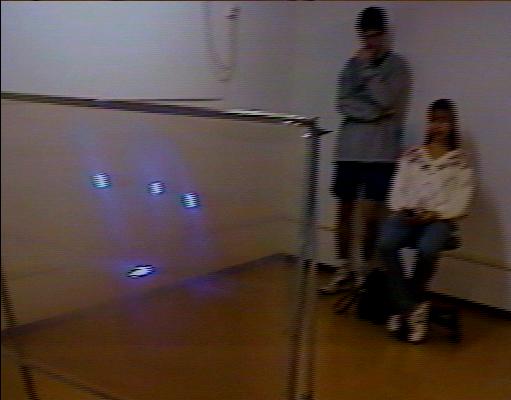 |
Public observing |
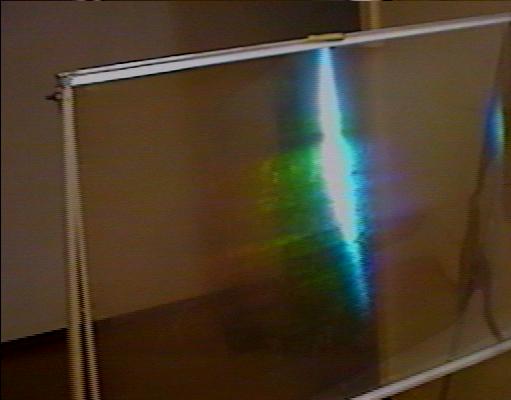 |
Seing the projector behind the screen, in the direction of incidence. |
The image start appearing in the difffraction direction.
| Image apearing in front of the screen
|
| .... .... 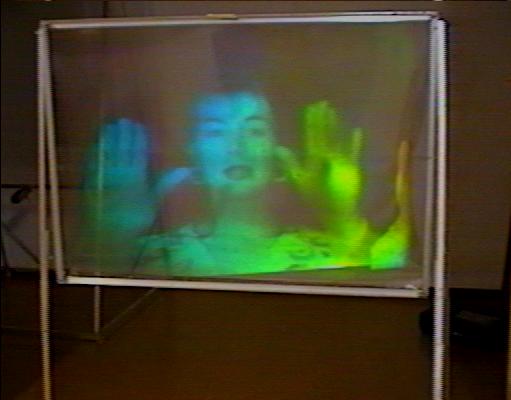 |
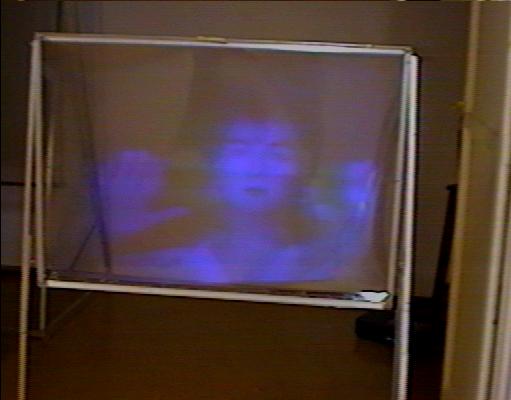 |
| .... ..........switching off the ambience light,
|
| ... ... and getting closer, one can see:
|
The sensation of depth is very complete. The
system is purely optical, without moving parts.
Watch a video of a presentation at a science meeting
There is enough space for observers:
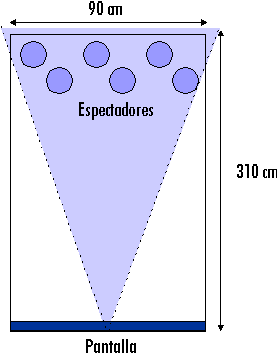
We made an experience to put the TV holoimage at the
theater, on the Institute of Arts, UNICAMP, 2002
Watch a
video of that experience (format Real, 3.6 Mb), that demonstrated
the possibility of showing the image to a line of about 15 people. By
sweeping the audience on the continuous displacement of the system, the
whole audience of a small theater can be reached.
But it is possible to improve even better, until
filling the complete volume with images, in front or behind the
screen, sequentially. A more complex optical system with moving parts
controlled by microcomputer can place the scene at any position. It may
come, f.ex., from behind the screen to go thru it like a perfect ghost.
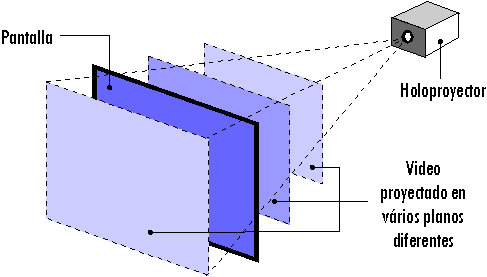
Registering in the computer the actor position and sincronizating the positions of the projected planes when observing, the result is excelent. The first public presentation of this system happened in Madrid in april 1995, in the "7ª Semana de Cine Experimental" (15). It was not television then, but a sequence of projected photographies appearing from behind the screen and passing through it like phantoms. In the same year a TV exhibit was made in a 89 cm x 55 cm screen (16) but in that case the plane was a fixed one.
Availability
The systems we described are prototipes but can already be used in exhibits, fairs, and can be rented at a reasonable price, similar to the price of material employed in publicity.
Vector system
The development of the electronic image with continuous
parallax was demonstrated in december 1994, when we showed a complete
vector image (representation point by point) (see
our technical articles)
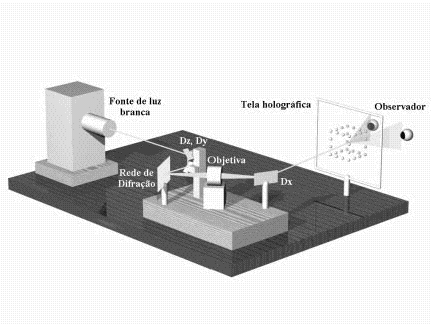
In the vector systema three computer controlled motors place a luminous point in space as a function of the three coordinates (horizontal, vertical, and depth). In a rapid sequence, a cube was made as an example, as we see in the pictures (two views, with the left view being repeated to allow who want to see 3D in the computer monitor to employ the parallel or the cross vision way)

(COLOCAR SEPARADAMENTE, ESQ-DIR, E DEPOIS DIR-ESQ)
Raster System
We later proposed a system for raster images using
conventional TV but in 3D because the whole volume was fulfilled by
means of a sequence of planes.
In april 1998 two M.Sc. thesis presented the result, with computer made figures which were animated and in large size screen (0.75 m x 1.14 m), at a size that overwhelms any other experience we know.
We named this system holoprojector by oblique plane sequencing and, although is not so bright and clear as the precedents, it appears to be the final solution for holographic TV. See now how it functions:

A TV projector launch frames which corresponds to
oblique planes within the scene and that by a diffractive chromatic
coding scheme are seeing around the screen like corresponding oblique
planes floating in space. A computer controlled mirror sincronizes the
position of the plane within a volume, which is fulfilled sequentially
plane by plane creating one frame of the volume scene.

Three-dimensional |

Selection of planes |
See in the vertical sequence below
estereoscopic pairs of frames of the first animation made. They were
registered from the actual big size holographic screen.

|
Computer animation: Walking man, may 1998. Left and right views of four frames of the animation If you want to see more images of this result,
|
Our results could now incorporate the recent digital TV capabilities to demonstrate a good quality holographic TV, registering real scenes.
Another System
We also made research in another possibility, were each
view of the scene is projected directly on the screen in a pure color.
We made this with three colors, see the scheme to understand its
functioning:
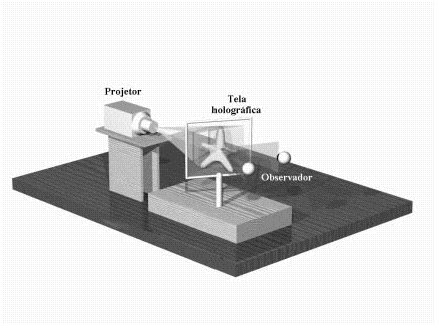
In the example above, two views are projected in two different colors, each one reaching one of the observer's eyes. Like in any previous use of the screen, its vertical diffusion allows the observer to see from different vertical positions. Although in this system he can not make lateral movements, it is possible to considerate the possibility of increasing the number of views and corresponding viewpoints by using a sequence of pure color filters, sincronized at the projection with the sequence of view obtained at the registering stage.
1) "UNICAMP da inicio ao cinema holográfico", newspaper "FOLHA DE SÃO PAULO", página G-6 inteira, 12.05.89
2) "Personaje de la semana", newspaper "Noticias del Mundo" (NY-USA), 30.06.89
3) newspaper "El Cronista Comercial" (Bs.As.-Arg.), august 1989.
4) newspaper "Clarín" (Bs.As.-Arg.), 29.09.89, p.11, 3/4 of a page.
5) In a program of the official shortwave argentine broadcasting, RAE (Arg.), 1989.
6) "TV holográfica", Rev.Telegráfica Electrónica (Arg.), Año 4, N11, august 1989, p.812.
7) "Físico do Brasil cria tela de televisão em três dimensões", newspaper Jornal do Brasil - Rio - RJ, 24.09.89.
8) "Televisão holográfica", Revista latinoamericana bilingue "Radiodifusão TV/Radiodifusión TV"- BR, octubre de 1989.
9) "Televisão holográfica, a revolução que vem da UNICAMP", rev. IPESI Eletro Eletrônica, jan-fev 1990, p.23-24
10) "TV tridimensional é criada no Brasil", capa e artigo da revista bilingue latinoamericana "Radiodifusão TV", junio de 1990, p.15-16.
11) "Nova dimensão na tela de TV", rev. "Superinteressante", fev.1990, p.11
12) "TV tridimensionale", television interview RAI 3, Trieste, Italia, 09.03.90.
13) "No telão, imagens nítidas e profundas", Rev."Globo Ciencia", V1, N1, p.109, august 1991.
14) "Físico cria projetor para o cinema em três dimensões", newspaper "Folha de São Paulo", 31.05.92 , p.6-18.
15) Exhibit at the hall of the cinemas Renoir, by invitation of KARAS STUDIO HOLOGRAFIA. Ref.: Sr. José Ramón Benito Peres, Presidente: <karasrb@ddnet.es> KARAS STUDIOS HOLOGRAFIA: Hospital, 12 , 28012 Madrid. Also reported at local newspapers.
16) Invited exhibit showed TV on holographic screen, internacional workshop of the Brazilian Commission for Optics/Comissão Brasileira de Óptica-CBO and Brazilian Society of Microwaves/ Sociedade Brasileira de Microondas-SBMO “Advanced Topics on Optolectronics, Optical Communications and Storage”, Exhibits Center of Cia. LIGHT, Rio de Janeiro-RJ, 24.07.95. Also divulgated at local journals..
Copia de alguns des artigos mencionados (1,6,7,8,9,10, 11,13,14, 15)
Commercial References_________________________________________
Prof. Lunazzi made many tecnical and didactical exhibits in Brasil, and some with commercial purpose. The first commercial one was made for SHARP, mounting two panels with holograms at SHARP's stand on the "Feria Nacional de Informática", Anhembi Exhibits Center, San Pablo-SP, 1984. The holographic elements generated strong pure colors capturing the attention of the public al along a gallery longer than 50 m, because resulted brighter than every other luminous display around.
Well, this is only one of a set of many catalogues we are preparing. Next will come a catalogue of holoprojectors that project objects, and another of a professional holographic camera.
If you need more informations, please contact Prof. Lunazzi <lunazzi @@ ifi.unicamp.br>
Links to similar projects:
CLARO TV This system is only a kind of screen that could be made holographically or not, but where the image appears 2D fixed at the screen. When not receiving projections, or if dark regions are present at the image, one can see through, as it happens in our real holographic screens. Elements of this kind and even larger ones are rented inBbrazil by VLOX, and people use to name it as holographics. Some singers use them at its shows.